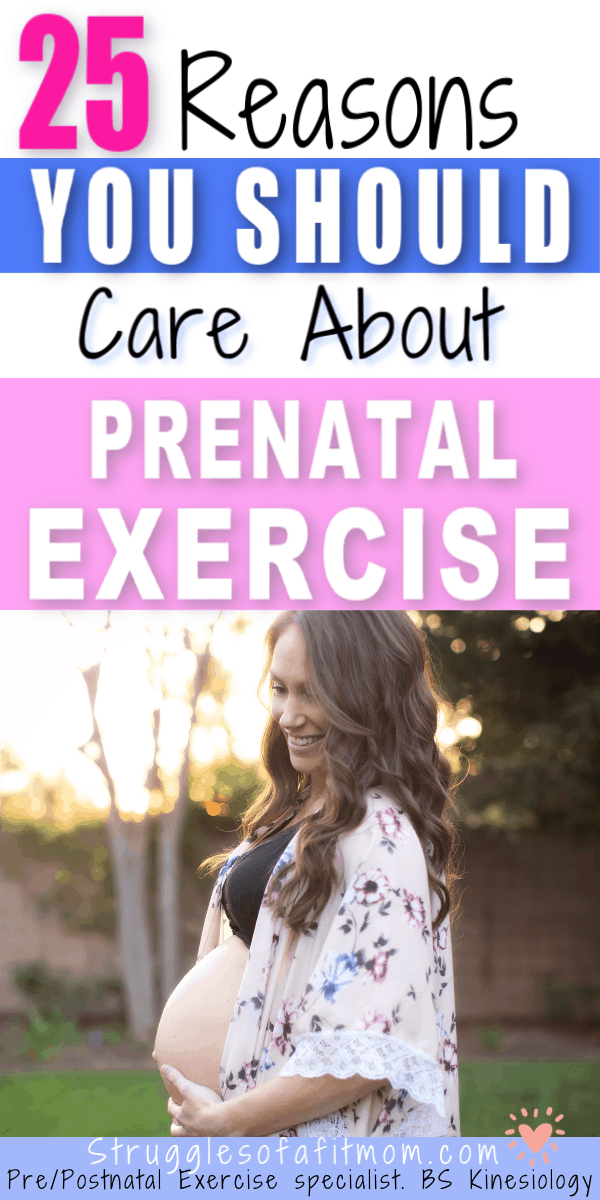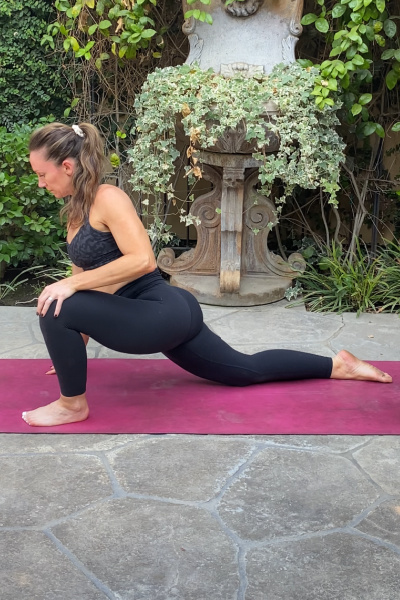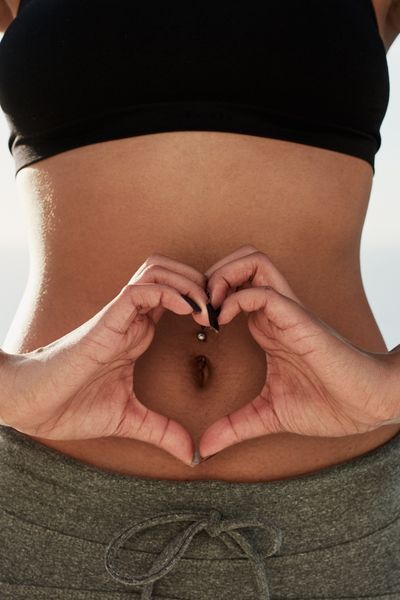Cellulite During Pregnancy-Debunking Unrealistic Expectations
(This post probably contains affiliate links. I receive a small commission at no cost to you through links shared on this website to help keep the information I provide free to you)
If you’re feeling a little self conscious about cellulite during pregnancy, you’re not alone.
While 85-90% of women develop cellulite at some point in their lives, it can have a huge impact on someones self-confidence, especially during pregnancy, and therefore shouldn’t be ignored.
Normalizing cellulite is just one piece in the puzzle to help women feel more confident and beautiful throughout their pregnancy!
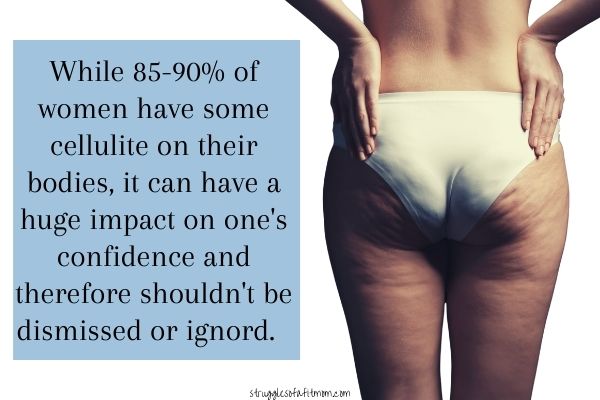
This article discusses cellulite in detail, including what it does to your skin, how cellulite develops during pregnancy, and what you should know about cellulite treatment options.
The more you know about cellulite, the more confident you will feel in the changes your body undergoes during this amazing (and temporary) period of time in your life.
Disclosure: Although I am a certified prenatal/postnatal exercise specialist and personal trainer, I am not YOUR trainer. The content on this blog is for informational purposes only and should not be a substitute of the information and advice you receive from a healthcare professional. This website does not replace the medical advice you receive from your provider.
What is Cellulite?
Cellulite is the bumpy, wavy or uneven appearance of the skin that is caused by fat deposits under the skin surface. (Source)
It happens when the collagen fibers between the skin and muscle separate from the underlying fat layers, resulting in uneven and “lumpy” textured skin.
It is usually more noticeable on parts of the body that have more subcutaneous fat such as:
- The buttocks
- Back of the thighs
- Hips
- Back of the upper arms
- Stomach
Related: Body Love During Pregnancy: The Tools You Need To Embrace The Journey With Confidence
Is It Normal To Get Cellulite During Pregnancy?
Yes!
Whether you’ve had cellulite or not, many women notice that cellulite becomes much more visible during pregnancy.
The amount of cellulite you develop depends on many factors such as genetics, body fat percentage, and age.
Comparing your body to unrealistic and photoshopped images on social media can cause unnecessary feelings of inadequacy.
Normalizing cellulite can help women feel confident during this exciting time of change.
What Causes Cellulite Development During Pregnancy?
Many moms develop cellulite or worsening cellulite during pregnancy because of the physical changes that happen to your body during pregnancy.
The amount of cellulite you have, as well as it’s visibility, is determined by a variety of factors, including:
Weight Gain and Increased Body Fat
Cellulite forms in areas with the most fat on your body.
Increase body fat or gaining more than the recommended amount of weight during pregnancy can result in increased cellulite formation during pregnancy.
Related: The Honest Truth About Pregnancy Weight Gain-Are You Gaining Too Much?

Natural Aging and Elasticity of the skin
Collagen protein is the most abundant protein in our bodies.
It is the building block of healthy joints, hair nails and skin.
We produce about 1% less collagen in the skin each year after the age of 20 which is why tendons, ligaments and skin firmness weaken with age.
Loss of elasticity in the skin contributes to more noticeable cellulite formation.
Related: 10 Science Backed Benefits of Collagen Protein For Postpartum Recovery
Genetics
This is one fo the main factors of cellulite development both during in both pregnant women and those who are not pregnant.
Some people are simply more predisposed to cellulite regardless of weight gain or other physical changes.
If your mother or grandmother had cellulite, there is a good chance you will have it as well.
Hormonal Changes
Hormone levels skyrocket during pregnancy, which is why pregnant women are more prone to develop cellulite or for existing cellulite to worsen.
The increase in Estrogen levels is especially responsible for more noticeable cellulite during pregnancy because it encourages the body to build up and store fat.
Bodily Fluids
Fat cells can absorb water, causing the connective tissues to stretch.
Increased water retention, blood volume and swelling can lead to cellulite being more noticeable or existing cellulite look worse.
Lack of exercise
Exercise, specifically strength training, can help reduce cellulite by improving muscle tone and reducing body fat.
Many moms are apprehensive to exercise or strength train during during pregnancy but the benefits are profound and can even help manage cellulite.
Unless you have pregnancy complications, prenatal exercise is both safe and recommended during for all expecting moms, regardless of prior fitness level.
As always, make sure you get the green like from your healthcare provider.
Related: The Ultimate Guide To Exercising Safely During Pregnancy
Poor Diet and Lifestyle Choices
Lastly, increased sodium and processed foods can lead to water retention and more noticeable cellulite formation.
Eating too many calories and not exercising enough can not only lead to cellulite but it can also increase your risk of gestational diabetes, high blood pressure and other health issues.
Will Cellulite Go Away After Pregnancy?
Many moms see improvement in their cellulite post pregnancy as the excess weight gained is lost.
Reducing overall body fat and improving muscular tone through strength training will give you the best chance at fighting cellulite postpartum.
Read this before diving head-first into a postpartum workout routine to help you resume exercise the right way.
Even if cellulite does not completely go away, please don’t let it get in the way of your happiness or self-confidence during this exciting time in your life!
Related: Postpartum Weight Loss: Melt Stubborn Baby Weight For Good

8 Ways To Naturally Reduce Cellulite During Pregnancy
While you can’t avoid cellulite during pregnancy altogether, there are many natural ways to help reduce cellulite formation or make it less noticeable.
Here are ten helpful tips to reduce cellulite naturally:
1. Strength Train To Improve Lean Muscle
Exercising regularly, specifically strength training, is an excellent way to improve the appearance of cellulite during pregnancy or prevent cellulite altogether.
Strengthening muscle tissue can significantly improve the tone and appearance of your skin and fat accumulation.
Staying active also helps improve blood flow, manage fluid retention, fight depression and maintain a healthy weight.
Many moms fear exercise during pregnancy but research shows that it is one of the best things you can do for both you AND your baby!
Where do you Start? The Ultimate Guide To Exercising Safely During Pregnancy

Related: 25 Shocking Things You Didn’t Know About Prenatal Exercise But Should!
2. Improve Your Eating Habits
Eating healthy foods and making simple changes such as swapping fried foods for lean meats can make a huge difference in your overall health and skin appearance.
Including foods that are high in protein, low in sodium and processed sugars helps prevent water retention and excess weight gain which are both contributing factors to cellulite.
It’s best to avoid extreme diets which can eliminate essential nutrients that are important for both you and your baby during pregnancy.
Switching to a healthy diet will control cellulite formation overtime.
Need Prenatal Nutrition Guidance? The Perfect Pregnancy Nutrition Plan Will Help You!
3. Lifestyle Changes
Poor lifestyle choices such as lack of exercise, poor sleeping habits, stress and excess consumption of processed foods and calories can lead to the more cellulite during pregnancy.
Pregnancy is the best time to focus on creating a healthy lifestyle by eating healthy foods, reducing stress, avoiding excessive weight gain and getting enough exercise.
4. Stay Hydrated
Increasing your water intake helps in reducing the appearance of cellulite by preventing fluid retention.
Staying hydrated also helps control excess calorie consumption and prevent early contractions.
5. Watch Your Weight
Following the recommended weight gain based on your pre-pregnancy bodyweight will help reduce pregnancy cellulite.
It is not recommended to intentionally lose weight during pregnancy but focus on gaining the right amount for you and your pregnancy.
Focusing on preventing excess weight gain during pregnancy reduces the chances of cellulite formation.
Related: Fat Loss During Pregnancy-Is It Safe?
6. Try Fascia Blasting
I love fascia blasting because it is a very effective massage technique that can help improve the appearance of cellulite as well as loosen stiff muscles.
Fascia is a type of connective tissue that surrounds and supports your muscles, tendons, and ligaments.
Some experts believe that when fascia becomes stiff or hardened, it can trap pockets of fat and contribute to the appearance of cellulite.
Fascia blasting is a massage technique that uses a tool to break up these hardened areas of fascia.
This is thought to improve the appearance of cellulite by freeing up trapped pockets of fat and reducing inflammation.
7. Skin Brushing
Some women swear by skin brushing (also known as dry brushing) to improve the appearance of cellulite.
It is thought that dry brushing helps stimulate the lymphatic system to remove toxins from your body and improve blood circulation.
Whether or not this is an effective treatment for cellulite, it feels amazing, can help improve softness of the skin and even help with stretch marks.
Theres no harm in trying it for some extra self-care!
I use dry brushing, almond oil, and cocoa butter to help prevent stretch marks as part of my pregnancy beauty regimen. (and its worked three times!)
Related: 6 Things I Did To Prevent Stretch Marks Through Three Pregnancies
8. Supplement With Collagen
Supplementing with collagen protein can help improve the elasticity of your skin and keep your connective tissue strong and supple.
One of the main benefits of taking a supplement is to replace lost collagen is that it may help improve cellulite appearance.
Collagen protein is one of the only supplements I have taken during all my pregnancy’s and postpartum to help prevent stretch marks and improve joint health.
9. Embrace The Journey
The best alternative, of course, would be to love the body you’re in, take care of it to stay healthy, and appreciate all that it does for you.
Remember that pregnancy is temporary and this time should be better focused on creating healthy eating and exercise habits that will help you manage your cellulite after pregnancy.
Related: Body Love During Pregnancy: The Tools You Need To Embrace The Journey

Other Frequently Asked Questions About Pregnancy Cellulite
Here are the most frequently asked questions I receive about cellulite during pregnancy.
Feel free to add any questions or comments below!
Is it Safe to Lose Weight During Pregnant for Cellulite Treatment?
I do not recommend intentional weight loss during pregnancy.
However, you should continue to monitor your weight and overall health during pregnancy.
If cellulite is a major concern for you then I would recommend continuing your exercise routine, focusing on muscle tone and maintaining a healthy diet.
What Are the Treatment Options for Cellulite?
Cellulite removal has not been proven to be effective, especially long term.
These treatments should be avoided during pregnancy and there is very limited data to prove whether they are even effective in permanently reducing cellulite.
Some treatment options include:
- Cellulite creams– Some studies show that topical creams containing caffeine can dehydrate cells which can make cellulite less visible. These creams need to be used daily in order to see results.
- Laser treatments– a laser is used to break up tough bands and fatty tissues beneath the skin that cause visible cellulite.
- Subcision- A medical procedure performed by a dermatologist who inserts a needle just under the skin to help break up the tough bands under the skin.
- Carboxytherapy– A medical treatment that inserts carbon dioxide (CO2) gas beneath the skin.
- Spa Treatments
- Radiofrequency
The downside to these cellulite treatments is that they may be expensive, time consuming, require multiple sessions for results and may only provide temporary improvement.
The most effective way to reduce cellulite over time without draining your pocketbook is to eat healthy foods, increase lean muscle mass and live a healthy and confident life!
What Is the Best Way to Get Rid of Cellulite on My Stomach?
Reducing the appearance of cellulite anywhere on the body, including your stomach, boils down to fat loss and muscle tone.
I do not recommend intentional fat loss during pregnancy however you can (and should) continue exercising and performing prenatal safe core exercises to strengthen your core.
Maintaining a strong core during pregnancy will help reduce aches and pains, assist in labor and speed up recovery postpartum.
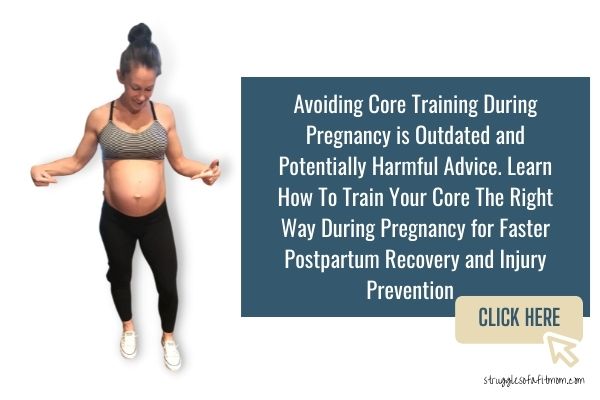
Can You Prevent Cellulite During Pregnancy?
Unfortunately you cannot avoid cellulite during pregnancy.
Your body needs extra body fat and fluids for a healthy pregnancy, both of which contribute to the formation of cellulite.
However, avoiding certain foods that make cellulite worse, such as refined sugars and carbohydrates, can help reduce cellulite.
Supplementing with collagen protein during pregnancy has been shown to improve skin elasticity which helps prevent cellulite from becoming worse or more noticeable.
Final Thoughts On Cellulite During Pregnancy
Even thought pregnancy cellulite is normal, if you feel like it is impacting your life during pregnancy, make sure to speak with your healthcare professional for assistance and guidance on how best to manage cellulite while pregnant.
Medical treatments should be the last resort and cannot replace creating healthy lifestyle habits.
FACT CHECK
Struggles of a Fit Mom uses only high-quality sources, including peer-reviewed studies, to support the facts within it’s articles. Read my editorial process to learn more about how I fact-check and keep my content accurate, reliable, and trustworthy.
Friedmann DP, Vick GL, Mishra V. Cellulite: a review with a focus on subcision. Clin Cosmet Investig Dermatol. 2017;10:17-23. Published 2017 Jan 7. doi:10.2147/CCID.S95830
Varani J, Dame MK, Rittie L, et al. Decreased collagen production in chronologically aged skin: roles of age-dependent alteration in fibroblast function and defective mechanical stimulation. Am J Pathol. 2006;168(6):1861-1868. doi:10.2353/ajpath.2006.051302
Weight Gain During Pregnancy. (2020). ACOG. https://www.acog.org/clinical/clinical-guidance/committee-opinion/articles/2013/01/weight-gain-during-pregnancy
Cellulite treatments: What really works? (n.d.). American Academy of Dermatology Association. https://www.aad.org/public/cosmetic/fat-removal/cellulite-treatments-what-really-works
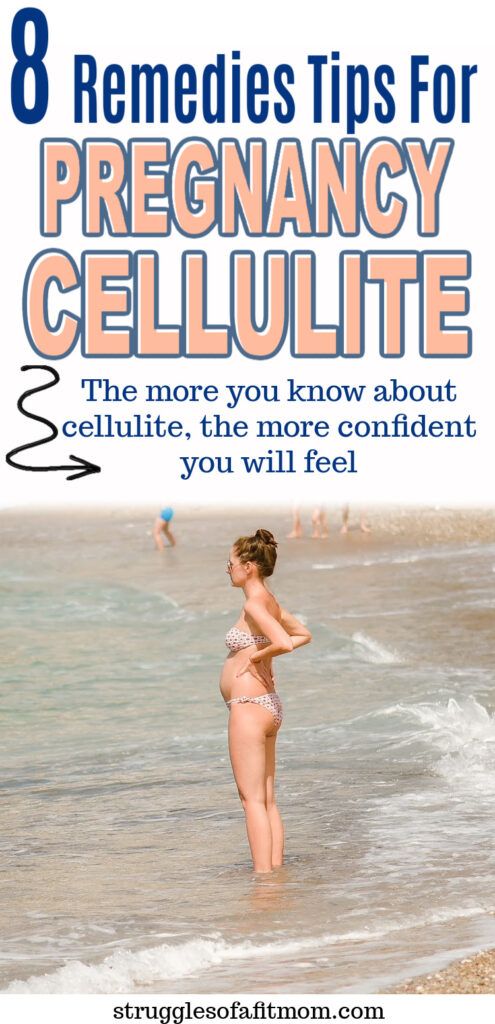

Brooke is a certified Prenatal and Postnatal Exercise Specialist with a Bachelors of Science degree in Kinesiology-Exercise Science. She is also a mom of 3 girls with more than 15 years of experience in health and fitness. Brooke’s goal at Struggles of a Fit Mom is to help motivate, educate and inspire other busy mamas who struggle with finding time, energy and motivation to take care of themselves in the chaos of motherhood.



